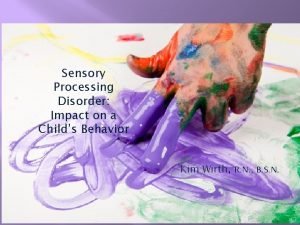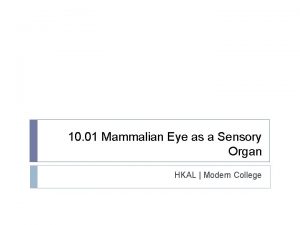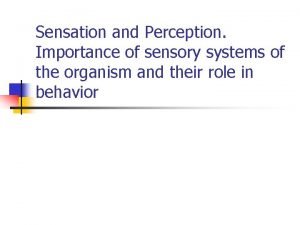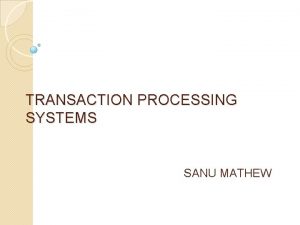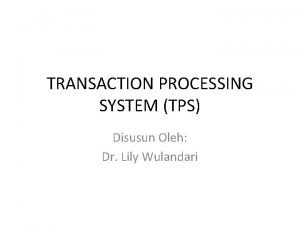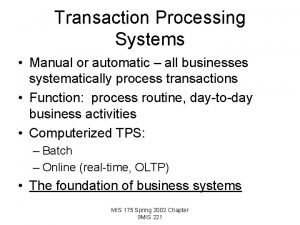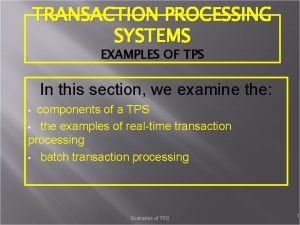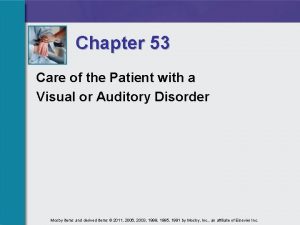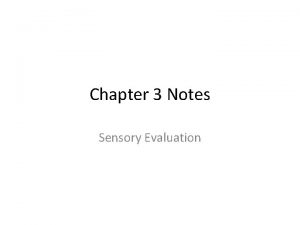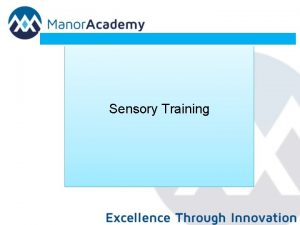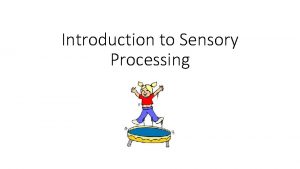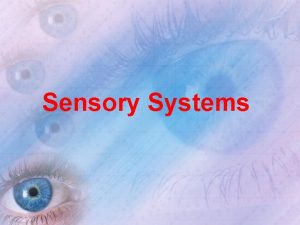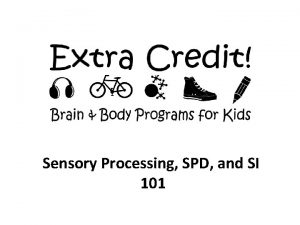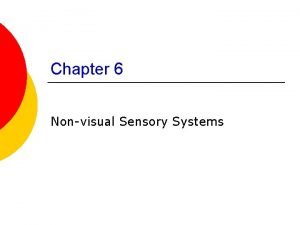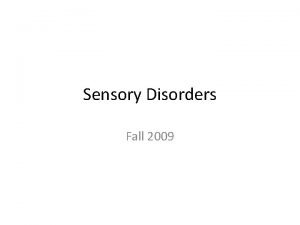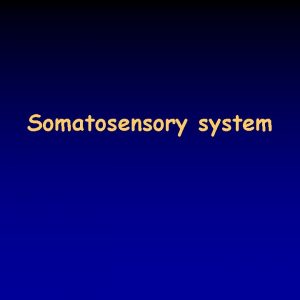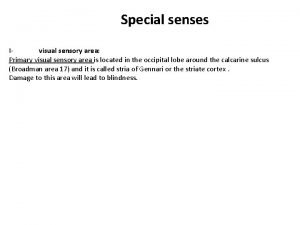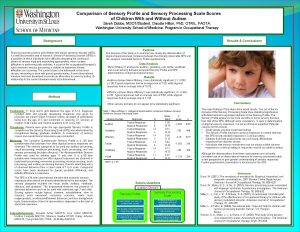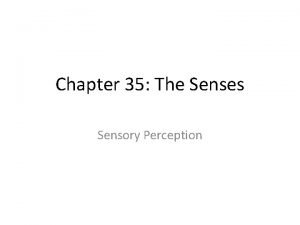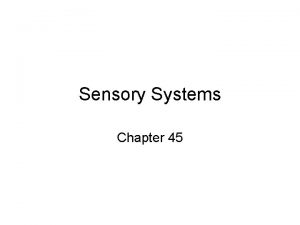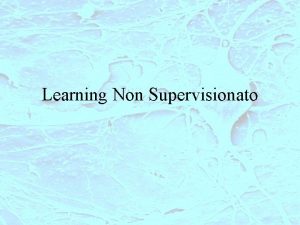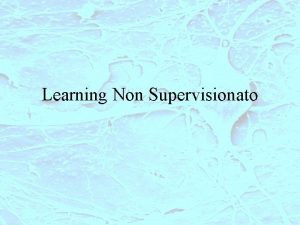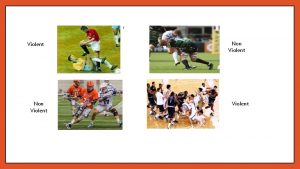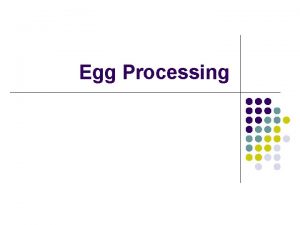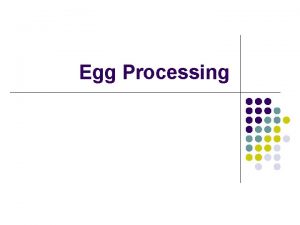Chapter 6 Non Visual Sensory Systems Sensory Processing





































- Slides: 37

Chapter 6 Non Visual Sensory Systems

Sensory Processing Species specific ¡ System ¡ l l l ¡ Receptors Pathways Brain areas Touch, Taste and Smell

The Somatosensory System Three interconnecting system: ¡ 1. Exteroceptive system, which senses external stimuli applied to the skin. ie skin sensations. This is divided into three general system, one for perceiving mechanical touch, one for perceiving thermal stimuli and one for perceiving pain. ¡ 2. Proprioception system, which is the sense of the relative placement of parts of the human body that comes from the receptors in our muscles and joints ¡ 3. Interroceptive system, which provides information about the internal environment of the body such as temperature and blood pressure.

Human Skin

Skin Receptors ¡ ¡ ¡ Pacinian corpuscles - touch Free-nerve endings - temperature, pain Meissner's corpuscles - pressure Merkel's disks - pressure Ruffini's corpuscles - vibration (not pressure)

Spinal Cord ¡ ¡ ¡ 31 pairs of spinal nerves Divided into four sections l Cervaical l Thoracic l Lumbar l Sacral Meninges for protection l Pia l Arachnoid l Dura

Dermatone ¡ ¡ Is a section of skin supplied by peripheral nerve fibres originating from a single dorsal root ganglion. loss of sensation in a specific dermatone can tell us exactly which part of the spine is damaged.

Somatosensory Pathways Sensory information travels from the sensory receptor to the brain by its own distinct pathway. ¡ These pathways lead into the spinal cord or brain stem, and connect with additional nerve cell clusters. ¡ Conscious and unconscious systems ¡

Dorsal Column-Medial Lemniscal System Conscious ¡ ¡ ¡ Touch and proprioception Two dorsal column nuclei. l meidal mucleus gracilis – lower part of body l lateral nucleus cuneatus – upper part of body Double dorsal projections then move across the brain and create a cluster of fibres dubbed the medial lemniscus. Synapse in the ventral posterolateral thalamic nuclei Third neurons project to the primary somatosensory cortex

Anterolateral System ¡ The anterolateral system consists of three different tracts: l Spinothlamic tract, which projects to the ventral posterior nucleus l Spinoreticular tract, which projects to the reticular formation l Spinotectal tract, which projects to the tectum

Common features of Conscious Somatosensory Pathways ¡ ¡ ¡ All have 3 neurons from receptor to cortex Cell body of first neuron is situated the dorsal root ganglia Second neuron crosses in spinal cord or brain stem All pathways ascend in the medial lemniscus to thalamus All synapse in the ventral posteriolateral thalamic nuclei Third neuron projects to the primary somatosensory cortex

Unconscious- Spinocerebellar tract ¡ ¡ The dorsal tract conveys information to the cerebellum about limb and joint position (proprioception). Pathway: dorsal root ganglia via the dorsal horn, and synapse in dorsal nucleus Axon fibres from the dorsal nucleus send this proprioceptive information via the dorsallateral funiculus to the cerebellum, Unconscious proprioceptive information processing occurs.

The Control of Pain ¡ ¡ Gate-control theory of pain (Melzack & Wall, 1965) Pain perceived only if it passes through gate PAG projects to spinal cord Endorphins can activate this system causing inhibition

Auditory System - The Eye ¡ ¡ ¡ Outer Ear l Folds of cartilage - pinna. Middle Ear l malleus (hammer) l incus (anvil) l stapes (stirrup), Inner Ear l Cochlea three fluid-filled sections. ¡ scala vestibuli ¡ scala media ¡ scala tympa

The Organ of Corti ¡ Primary receptor unit in cochlea l Hair cells in basilar membrane l Hairs or cilia are attached to tectorial membrane

Transduction of Sound Waves Transduced into nerve impulses ¡ Excitation of auditory receptors l Bending of cilia ¡

Transduction of Sound Waves into ¡ ¡ Opening of K+ ion channels Influx of K+, resulting in membrane depolarization Influx of Ca++, which results in neurotransmitter release Cilia return to original position - K+ ion channels close

Pathways of the Auditory Cortex • Hair cells • Cochlear nerve • Auditory nerve • Cochlear nucleus, • Superior olivary nucleus • Inferior colliculus • medial geniculate nucleus Thalamus • Auditory cortex • Secondary auditory cortex

Primary Auditory cortex ¡ ¡ Called Heschl's gyrus. BA 41/42

Detection of frequency ¡ ¡ ¡ Place theory of pitch (Helmholz) l Basilar membrane varies in width & thickness Frequency theory of pitch (Rutherford) l Whole basilar membrane vibrates at rate of stimulus frequency l Up to 4000 Hz - beyond that place theory accounts for frequency Volley Theory (Wever) Groups of neurons to fire repeatedly, creating a string of nerve impulses (called a volley) faster than the firing rate of any single nerve cell

Detection of Amplitude ¡ ¡ High frequency sounds - rate of receptor responding Low frequency sounds - number of neurons firing

Conduction Deafness ¡ ¡ When sound is abnormally conducted through the outer ear, middle ear, or both, and is unable to get to the cochlea, the resulting condition is called conduction deafness Fused ossicles

Sensorineural Deafness ¡ ¡ ¡ Lack of sensitivity in the inner ear May be caused by l exposure to loud noise. l metabolic disorder l genetic disorder l an infection The gene GJB 2 have been estimated to cause as much as fifty percent of congenital or early-onset hearing impairment

Central Deafness ¡ ¡ ¡ Loss their hearing due to an injury to the auditory system in the brain Injury to: l auditory cortex l the brain stem l the superior colliculus Bilateral lesions of the auditory cortex leads to a condition known as cortical deafness

Vestibular System ¡ ¡ ¡ Two major parts: l semicircular canals l vestibular Semicircular canals l the horizontal (lateral) l the anterior (superior) l the posterior (inferior) Vestibular l sacsutricle l saccule.

Vestibular Pathways ¡ ¡ ¡ The movement of fluid pushes against cupula, Hair cells that convert the mechanical motion into electrical signals. Vestibular hair cells, synapse with the bipolar cells that make up the vestibular ganglia These gather together, forming the vestibular nerve. Vestibular nerve connect with the cochlear nerve fibres to create the auditory nerve (cranial nerve VIII).

The Gustatory Sense - Sense of Taste ¡ Distinguishes between 5 tastes: sweet, sour, bitter, salty and umani

Taste Buds ¡ Taste buds lie in or around raised protrusions of the tongues surface known as papillae. Four types: l Fungiform papillae l Foliate papillae l Filiform papillae l Circumvallate papillae

Gustatory Pathway ¡ ¡ ¡ Taste receptors 7 th, 9 th, and 10 th cranial nerves Nucleus of the solitary tract of the medulla Ventral posteromedial thalamic nucleus Primary gustatory cortex l l anterior insula frontal operculum

The Olfactory Sense - Sense of Smell ¡ ¡ ¡ Distinguishes between various odors nasal pathway has an area of about 10 cm² Odours stimulate adenylate cyclase to synthesise cyclic AMP (c. AMP) via a G protein called Golf. When c. AMP is present, it opens Na+ channels depolarising membrane. This causes information to be transmitted directly to the brain.

Olfactory Pathway ¡ ¡ ¡ Olfactory receptors (located on the olfactory epithelium) Mitral cells of the olfactory bulbs Primary olfactory cortex (in the limbic system)

Skin

Spinal Cord

Sensory Pathways

Auditory System

Gustatory system

Readings ¡ Barnes, J. (2011). Essential Biological Psychology (Chapter 6). London: Sage. ¡ The Essentials Hollins, M. (2010). Somesthetic senses. Annu Rev Psychol, 61, 243 -271 ¡ Next Steps Shamma, S. A. , & Micheyl, C. (2010 ). Behind the scenes of auditory perception. Curr Opin Neurobiol. , 20(3), 361 -366. ¡ Delving Deeper Uneyama, H. , Kawai, M. , Sekine-Hayakawa, Y. , & Torii, K. (2009). Contribution of umami taste substances in human salivation during meal. J Med Invest, 56 Suppl, 197 -204.
 Je lève les yeux vers les montagnes maranatha
Je lève les yeux vers les montagnes maranatha Sensory processing disorder dsm
Sensory processing disorder dsm Sensory processing disorder dsm
Sensory processing disorder dsm Sequence of sensory processing
Sequence of sensory processing Sensory systems
Sensory systems Bottom up processing
Bottom up processing Bottom up processing vs top down processing
Bottom up processing vs top down processing Bottom up and top down processing
Bottom up and top down processing Neighborhood processing in image processing
Neighborhood processing in image processing Primary and secondary processing of food
Primary and secondary processing of food Image enhancement point processing techniques
Image enhancement point processing techniques Histogram processing in digital image processing
Histogram processing in digital image processing Parallel processing vs concurrent processing
Parallel processing vs concurrent processing Neighborhood processing in digital image processing
Neighborhood processing in digital image processing What is point processing in digital image processing
What is point processing in digital image processing Morphological
Morphological Top down vs bottom up psychology
Top down vs bottom up psychology Batch processing vs interactive processing
Batch processing vs interactive processing Visual basic image processing
Visual basic image processing Bahasa pemrograman konvensional
Bahasa pemrograman konvensional Difference between hdbms and ndbms
Difference between hdbms and ndbms Payroll transaction processing system
Payroll transaction processing system Tps sistem informasi
Tps sistem informasi Systems, applications, products in data processing
Systems, applications, products in data processing Systems applications and products in data processing
Systems applications and products in data processing 0ï
0ï Manual transaction processing system
Manual transaction processing system Transaction processing system flow chart
Transaction processing system flow chart Chapter 53 care of the patient with a sensory disorder
Chapter 53 care of the patient with a sensory disorder Chapter 3 sensory evaluation the human factor answer key
Chapter 3 sensory evaluation the human factor answer key Sensory evaluation the human factor
Sensory evaluation the human factor Chapter 3 sensory evaluation the human factor
Chapter 3 sensory evaluation the human factor Non projected visual
Non projected visual Decision support systems and intelligent systems
Decision support systems and intelligent systems Engineering elegant systems: theory of systems engineering
Engineering elegant systems: theory of systems engineering Embedded systems vs cyber physical systems
Embedded systems vs cyber physical systems Engineering elegant systems: theory of systems engineering
Engineering elegant systems: theory of systems engineering Non nobis domine non nobis sed nomini tuo da gloriam
Non nobis domine non nobis sed nomini tuo da gloriam

